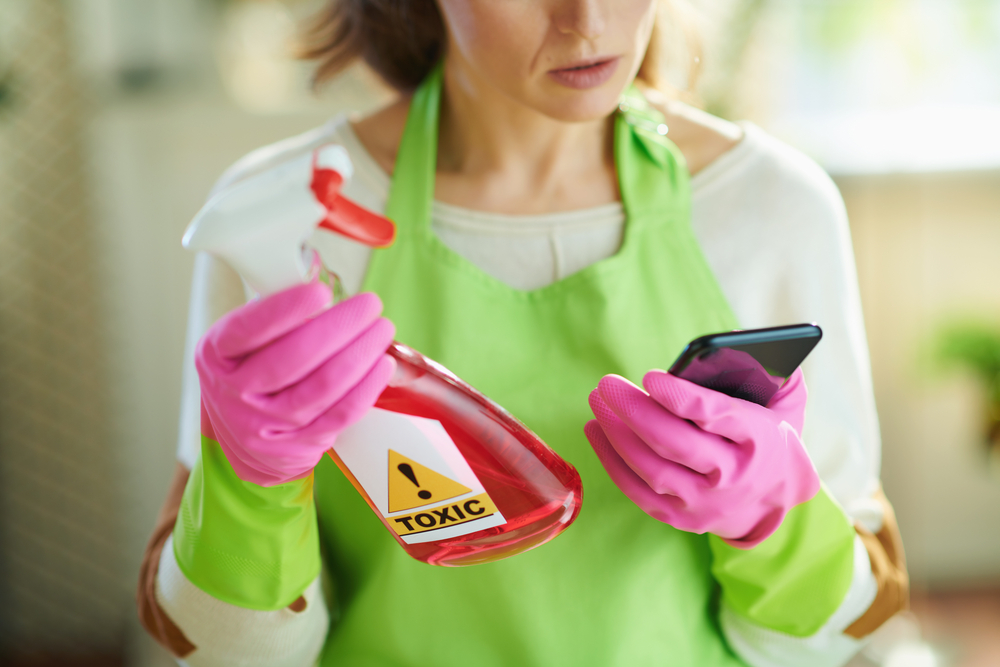Get a Free Estimate
Your information will not be shared. Safe Spray will send you a custom estimate.

Having a clean home is essential to you and your family’s mental and physical well-being. You know that, so you purchase what seems the best cleaning products to do the job.
Unfortunately, those same products you rely on to maintain your family’s health may have the opposite effect due to the chemicals involved. Below are six hazardous ingredients to watch for in your favorite disinfectant.
1. Chlorine
Chlorine is a powerful substance used to clean pool water, bleach clothes, clean toilets, and disinfect surfaces. Some people use it straight from a bleach container, while others buy it powder or chemical spray.
Chlorine produces fumes that can irritate the eyes, nose, and throat and can be even more dangerous for heart and lung issues. Additionally, it can burn or damage the skin if contact is made.
2. Sodium Hypochlorite
Sodium hypochlorite is used in many disinfectants and for bleaching. It most often gets used as liquid bleach.
While we mentioned bleaching products above with chlorine, this is listed separately for a very good reason: you should never use it combined with other cleaners.
Sodium hypochlorite reacts to so many other chemicals and can quickly turn into a toxic gas. For example, mixing it with ammonia can create chlorine gas — a chemical weapon that has been used in wartimes. So it is certainly not something you want in your home.
The best thing to do is avoid mixing sodium hypochlorite with any other chemical or cleaner. Additionally, if you use any form of bleach to clean, be sure to wash the area with soap and water before using another chemical to clean there.
3. Phenol
Phenol is in air fresheners, all-purpose cleaners, disinfectants, insecticides, and so much more. Unfortunately, it is very caustic and can easily penetrate the skin. It can damage the central nervous system, respiratory tract, kidneys, liver, and more.
4. Ethanol
Ethanol, otherwise known as alcohol, is common in disinfectant products. It has been found to impact the skin’s pores so that viruses, bacteria, and germs can more easily enter the body through the skin. Avoiding use is best, but at a minimum, wear gloves. So there is no direct contact with the skin.
5. Formaldehyde
Formaldehyde is in many cleaners, disinfectants, and even building products. It is a gas that is colorless but has a powerful smell. Formaldehyde has been found to lead to many physical and mental issues, which include:
- Depression
- Attention problems
- Headaches
- Insomnia
- Irritability
It can also lead to ALS or amyotrophic lateral sclerosis. It is commonly referred to as Lou Gehrig’s disease. This is a disease that can impact the brain’s control over the body.
Formaldehyde is also a very flammable gas, meaning it also poses fire and explosion risks in a home.
6. Lathering Agents and Fragrances
Many cleaners, disinfectants, and laundry detergents come with agents that suds up (known as diethanolamine (DEA)). They also come with fragrances such as triethanolamine (TEA). When used with the preservatives in many cleaners, DEA and TEA produce nitrosamines.
Nitrosamines are carcinogens that easily enter the skin. As a result, they can cause ongoing health issues, including cancer and hormone conditions.
The chemicals listed here are just some of the most hazardous ingredients to watch out for, but it is by no means a comprehensive list. Many cleaning agents can cause physical, mental, and emotional issues.
Additionally, they are not always listed under their actual names. For example, some get masked by the title “Fragrance.” Formaldehyde is sometimes listed as “formic aldehyde,” “trioxane,” and several others.
It can be nearly impossible to determine what is actually in the cleaners by looking at the ingredient list. The safest way to protect your family from these potential risks is to use organic cleaners void of added chemicals.

Get Your Free Quote Today!
We also offer a no obligation, free onsite service estimate.

 Get a free Consultation
Get a free Consultation